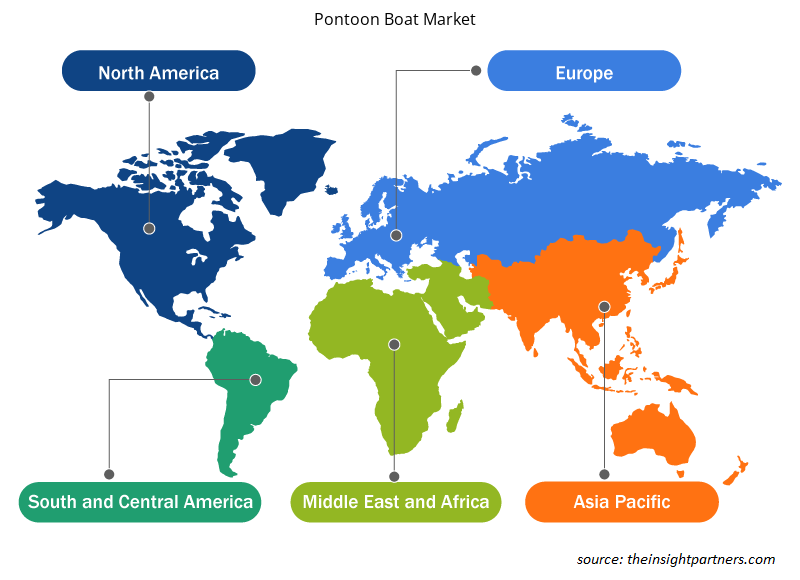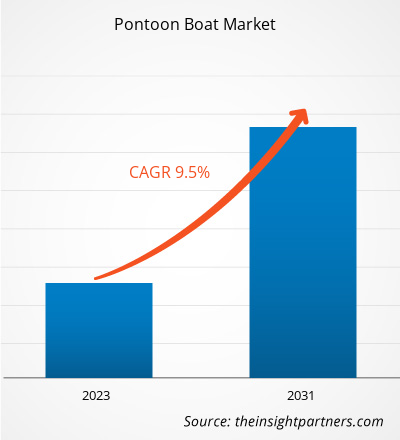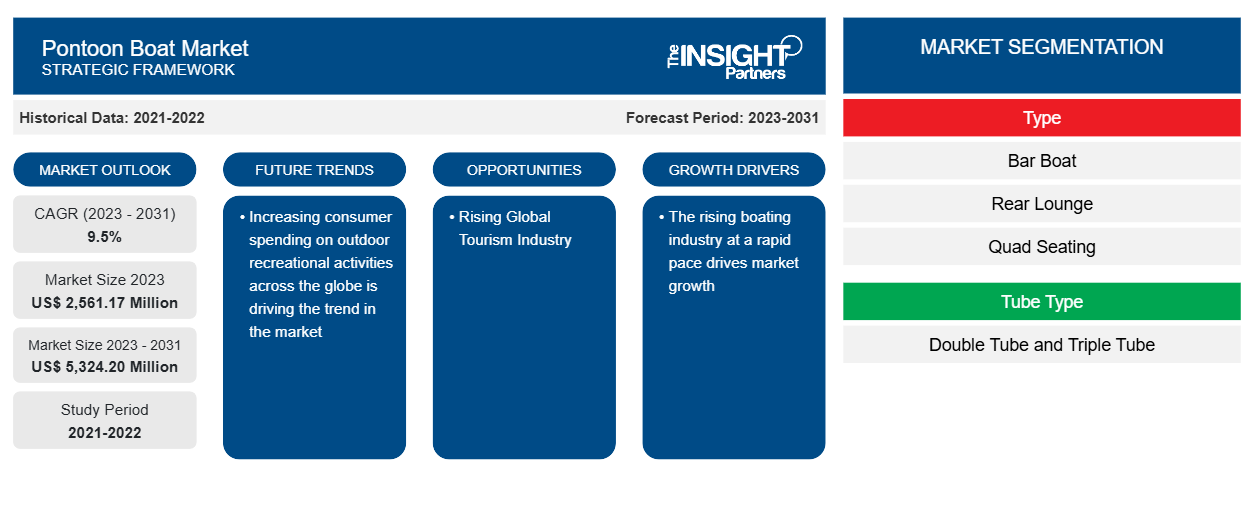Si prevede che la dimensione del mercato delle barche pontone raggiungerà i 5.324,20 milioni di dollari entro il 2031, rispetto ai 2.561,17 milioni di dollari del 2023. Si prevede che il mercato registrerà un CAGR del 9,5% nel periodo 2023-2031. Il crescente numero di consumatori in attesa di attività ricreative all'aperto in tutto il mondo sta guidando la tendenza del mercato.
Analisi del mercato delle barche pontone
L'uso generale crescente di barche a ponte e pontoni sta espandendo la loro adozione in modo esponenziale. Pertanto, per attrarre gli individui, si stanno verificando sviluppi nelle barche pontoni. Di seguito sono riportati alcuni esempi dello stesso:
Nel 2021, BRP , leader nel settore delle moto d'acqua con il suo marchio Sea-Doo , ha ora presentato un Sea-Doo Switch 2022 (un'espansione della linea Sea-Doo ). Si tratta di un nuovissimo pontone che offre un'incredibile versatilità e stabilità della piattaforma del pontone. Il design del ponte a cambio rapido può essere completamente riconfigurato per soddisfare le esigenze di una singola battuta di pesca, un picnic in famiglia e una sessione di wakeboard . Inoltre, il nuovo portafoglio Manitou ha continuato la tradizione di BRP di offrire incredibili esperienze in acqua per la famiglia e gli amici. Manitou ha svelato la sua gamma di modelli dell'anno 2022, che aggiunge più potenza e caratteristiche premium a una gamma di pontoni ad alte prestazioni, di lusso e per il tempo libero, che è già eccellente.
Panoramica del mercato delle barche pontone
Il mercato delle barche pontone è in continua evoluzione. Da semplice barca galleggiante squadrata a lussuosa barca da diporto, una barca pontone offre un'esperienza rilassante agli individui per emozionanti corse tonificanti. Le barche pontone sono utilizzate per diversi scopi come il nuoto, la crociera e gli sport acquatici , nonché per rilassarsi. Per attività ricreative, come lo sci, il wakeboard e il tubing, le barche hanno ganci di traino e gavoni di stoccaggio, che sono abbastanza grandi da contenere sci d'acqua o kneeboard , e piattaforme da bagno con scale grandi e stabili per salire/scendere dalla barca. Le barche pontone sono barche a ponte piatto alimentate da un motore fuoribordo. Queste barche hanno forme quadrate/rettangolari che le rendono ideali per acque agitate/agitate. Le barche pontone sono anche ampiamente utilizzate nei laghi per intrattenimento, relax e pesca. Queste barche hanno un ampio spazio sul ponte che aggiunge più posti a sedere, spazio di stoccaggio extra, lusso, comfort e spazio aggiuntivo per diverse attività in base agli interessi degli utenti.
Personalizza questo report in base alle tue esigenze
Riceverai la personalizzazione gratuita di qualsiasi report, comprese parti di questo report, o analisi a livello nazionale, pacchetto dati Excel, oltre a usufruire di grandi offerte e sconti per start-up e università
-
Scopri le principali tendenze di mercato in questo rapporto.Questo campione GRATUITO includerà analisi di dati che spaziano dalle tendenze di mercato alle stime e alle previsioni.
Driver e opportunità del mercato delle imbarcazioni pontone
La rapida crescita del settore nautico sta trainando la crescita del mercato.
La crescente industria nautica, in particolare la nautica da diporto in tutto il mondo, guida la crescita del mercato delle barche pontone. Inoltre, un aumento delle vendite di barche a ponte e pontone dovuto al crescente numero di passeggeri per gli sport acquatici e le attività ricreative svolgerà un ruolo magnifico nel generare domanda di pontoni. Inoltre, con l'emergere di applicazioni basate su IoT , la tendenza del tracciamento in tempo reale e delle barche intelligenti sta accelerando. Si prevede che l'integrazione di IoT nelle barche pontone creerà opportunità commerciali redditizie per i produttori e i fornitori di barche pontone nei prossimi anni. Tuttavia, la bassa velocità e le prestazioni inefficienti delle barche pontone in acque agitate frenano la crescita del mercato delle barche pontone.
Crescente industria turistica globale
L'industria del turismo in tutto il mondo sta aumentando rapidamente. Secondo le ultime cifre pubblicate dall'UNWTO , a luglio 2021, quasi 54 milioni di turisti internazionali hanno viaggiato in tutto il mondo. Questa è la cifra più alta registrata dall'inizio della crisi sanitaria che ha portato l'industria del turismo globale a un punto morto virtuale per molti mesi. Questa cifra rappresenta anche un aumento di circa il 58% rispetto ai 34 milioni di turisti internazionali di luglio 2020. Inoltre, secondo il World Travel and Tourism Council, si prevede che l'Arabia Saudita raggiungerà i 22,1 milioni di arrivi internazionali entro il 2025, quasi il 40% in più rispetto agli attuali visitatori di Dubai.
Inoltre, l'Organizzazione Mondiale del Turismo prevede che il Sud America riceverà 78,2 milioni di turisti entro il 2027, generando 82 miliardi di dollari USA per l'economia locale. Inoltre, paesi come Emirati Arabi Uniti, Australia, Stati Uniti, Canada, Brasile, Italia, Francia, Germania, India e Cina sono tra le principali destinazioni turistiche. Pertanto, la crescente industria del turismo in queste destinazioni aumenta le attività di vela ricreativa e sport acquatici. Ad esempio, l' effetto valanga del flusso turistico nazionale e internazionale nei paesi europei sta contribuendo in modo massiccio all'industria della nautica da diporto.
Analisi della segmentazione del rapporto di mercato delle barche pontone
- I segmenti chiave che hanno contribuito alla derivazione dell'analisi di mercato delle imbarcazioni pontone sono la base del tipo, del tipo di tubo, del tipo di propulsione, delle dimensioni, dell'applicazione e dei paesi.
- In base al tipo, il mercato è segmentato in barche bar, lounge posteriori, sedili quadrupli, modelli ad arco, double decker e altri. Il segmento lounge posteriore ha detenuto la quota di mercato maggiore nel 2020 perché questi tipi di pontoni ospitano facilmente più persone. In termini di tipo di tubo, il mercato delle barche pontoni è diviso in doppio tubo e triplo tubo. Nel 2023, il segmento triplo tubo ha detenuto la quota di mercato maggiore. Poiché i pontoni a tre tubi sono più stabili e generalmente hanno motori più grandi con maggiore potenza, sono ampiamente utilizzati tra i passeggeri.
- In base al tipo di propulsione, il mercato è segmentato in motori monomotore, bimotore ed elettrici. Il mercato per il segmento bimotore ha detenuto la quota di mercato maggiore nel 2023.
- In base alle dimensioni, il mercato delle barche pontone è segmentato in meno di 20 piedi, 20-30 piedi e più di 30 piedi. La dimensione 20-30 piedi ha dominato il mercato nel 2023 e ha detenuto la quota maggiore poiché le barche di queste gamme possono facilmente ospitare fino a 10-13 passeggeri.
- Il mercato delle barche pontone, per applicazione, è segmentato in pesca, sport acquatici, attività ricreative e altro. L'applicazione ricreativa ha detenuto la quota di mercato più grande nel 2023, poiché la domanda di crociera tra gli individui è in aumento nei paesi del mondo.
Analisi della quota di mercato delle imbarcazioni pontone per area geografica
L'ambito geografico del rapporto sul mercato delle imbarcazioni pontone è suddiviso principalmente in cinque regioni: Nord America, Asia Pacifico, Europa, Medio Oriente e Africa, Sud e Centro America.
Si prevede che il Nord America avrà la quota maggiore nel 2023. Ciò è dovuto alla crescente domanda di imbarcazioni da diporto. La National Marine Manufacturers Association (NMMA), che rappresenta i produttori nordamericani di imbarcazioni da diporto, motori e accessori marini, segnala che le vendite al dettaglio di unità di imbarcazioni nuove negli Stati Uniti sono aumentate nel 2023 di circa il 12,4% rispetto al 2022. Nel 2022 sono state vendute più di 398.000 imbarcazioni da diporto nuove. Pertanto, le crescenti vendite di imbarcazioni per attività ricreative stanno influenzando la crescita del mercato delle imbarcazioni pontone.
Approfondimenti regionali sul mercato delle imbarcazioni pontone
Le tendenze regionali e i fattori che influenzano il mercato delle imbarcazioni pontone durante il periodo di previsione sono stati ampiamente spiegati dagli analisti di Insight Partners. Questa sezione discute anche i segmenti e la geografia del mercato delle imbarcazioni pontone in Nord America, Europa, Asia Pacifico, Medio Oriente e Africa, e America centrale e meridionale.

- Ottieni i dati specifici regionali per il mercato delle barche pontone
Ambito del rapporto sul mercato delle barche pontone
| Attributo del report | Dettagli |
|---|---|
| Dimensioni del mercato nel 2023 | 2.561,17 milioni di dollari USA |
| Dimensioni del mercato entro il 2031 | 5.324,20 milioni di dollari USA |
| CAGR globale (2023-2031) | 9,5% |
| Dati storici | 2021-2022 |
| Periodo di previsione | 2023-2031 |
| Segmenti coperti |
Per tipo
|
| Regioni e Paesi coperti |
America del Nord
|
| Leader di mercato e profili aziendali chiave |
|
Densità degli attori del mercato: comprendere il suo impatto sulle dinamiche aziendali
Il mercato del Pontoon Boat Market sta crescendo rapidamente, spinto dalla crescente domanda degli utenti finali dovuta a fattori quali l'evoluzione delle preferenze dei consumatori, i progressi tecnologici e una maggiore consapevolezza dei vantaggi del prodotto. Con l'aumento della domanda, le aziende stanno ampliando le loro offerte, innovando per soddisfare le esigenze dei consumatori e capitalizzando sulle tendenze emergenti, il che alimenta ulteriormente la crescita del mercato.
La densità degli operatori di mercato si riferisce alla distribuzione di aziende o società che operano in un particolare mercato o settore. Indica quanti concorrenti (operatori di mercato) sono presenti in un dato spazio di mercato in relazione alle sue dimensioni o al valore di mercato totale.
Le principali aziende che operano nel mercato delle imbarcazioni pontone sono:
- Pontoni Aloha
- BRP
- Terrazza galleggiante
- Kiwi Kraft Ltd
- Barche di Nazareth
- Polaris Inc.
Disclaimer : le aziende elencate sopra non sono classificate secondo un ordine particolare.

- Ottieni una panoramica dei principali attori del mercato delle barche pontone
Notizie e sviluppi recenti sul mercato delle barche pontone
Il mercato delle imbarcazioni pontone viene valutato raccogliendo dati qualitativi e quantitativi dopo la ricerca primaria e secondaria, che include importanti pubblicazioni aziendali, dati associativi e database. Di seguito sono elencati alcuni degli sviluppi nel mercato delle imbarcazioni pontone:
- Lowe Boats, produttore leader di barche in alluminio di alta qualità e dotate di tutti gli optional, ha annunciato oggi un nuovo stile audace e una serie di funzionalità premium per l'anno modello 2023 con il lancio delle barche pontone della serie SF 2023. Con il pensiero e l'intuizione del cliente inclusi in ogni dettaglio, la serie SF è stata realizzata alla perfezione per combinare la pesca e la ricreazione in acqua in un design costruito per soddisfare. Il nuovo design di recinzioni e mobili, così come le stazioni di pesca rinnovate e le opzioni di stoccaggio migliorate, forniscono esattamente ciò di cui i diportisti hanno bisogno per trascorrere una bella giornata in acqua e renderla fantastica.
- (Fonte: sito web aziendale, febbraio 2024)
- Crest Marine, LLC., una sussidiaria di MasterCraft Boat Holdings, Inc., ha annunciato l'espansione del suo portafoglio con il lancio di un nuovo marchio indipendente di pontoni di lusso, Balise Pontoon Boats (Balise). (Fonte: comunicato stampa, aprile 2024)
Copertura e risultati del rapporto sul mercato delle imbarcazioni pontone
Il rapporto "Dimensioni e previsioni del mercato delle barche pontone (2021-2031)" fornisce un'analisi dettagliata del mercato che copre le seguenti aree:
- Dimensioni e previsioni del mercato delle imbarcazioni pontone a livello globale, regionale e nazionale per tutti i segmenti di mercato chiave coperti dall'ambito
- Tendenze del mercato delle imbarcazioni pontone e dinamiche di mercato come conducenti, restrizioni e opportunità chiave
- Analisi PEST e SWOT dettagliate
- Analisi del mercato delle imbarcazioni pontone che copre le principali tendenze del mercato, il quadro globale e regionale, i principali attori, le normative e i recenti sviluppi del mercato
- Analisi del panorama industriale e della concorrenza che copre la concentrazione del mercato, l'analisi della mappa di calore, i principali attori e gli sviluppi recenti per il mercato delle barche pontone
- Profili aziendali dettagliati
- Analisi storica (2 anni), anno base, previsione (7 anni) con CAGR
- Analisi PEST e SWOT
- Valore/volume delle dimensioni del mercato - Globale, Regionale, Nazionale
- Industria e panorama competitivo
- Set di dati Excel
Report recenti
Rapporti correlati
Testimonianze
Motivo dell'acquisto
- Processo decisionale informato
- Comprensione delle dinamiche di mercato
- Analisi competitiva
- Analisi dei clienti
- Previsioni di mercato
- Mitigazione del rischio
- Pianificazione strategica
- Giustificazione degli investimenti
- Identificazione dei mercati emergenti
- Miglioramento delle strategie di marketing
- Aumento dell'efficienza operativa
- Allineamento alle tendenze normative























 Ottieni un campione gratuito per - Mercato delle barche pontone
Ottieni un campione gratuito per - Mercato delle barche pontone